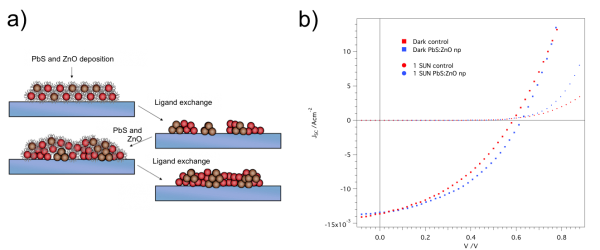Solution Processed Bulk Heterojunction PbS:ZnO Solar Cells
- Category: Energy, Materials, Nanotechnology
- Tags: andrea maurano, dong-kyun ko, joel jean, patrick brown, solar cells, vladimir bulovic
Colloidal lead sulfide quantum dot (PbS QD) solar cells have recently shown attractive improvements in efficiency [1]. PbS QDs have been investigated in various device architectures—including Schottky junction, depleted planar heterojunction, and ordered bulk heterojunction photovoltaic (PV) architectures—with the aim of maximizing light absorption while maintaining efficient charge transport [1] . However, the thickness of the PbS QD layer in the aforementioned architectures remains limited by the relatively short exciton diffusion length characteristic of all QD films. We developed a novel architecture in which PbS QDs and zinc oxide (ZnO) nanoparticles are co-deposited from solution to form a bulk heterojunction (BHJ). Much like a typical polymer BHJ solar cell, these PbS QD PV devices can decouple the light absorption, which is proportional to device thickness, from the exciton diffusion length [2] . We fabricated these BHJ PbS QD:ZnO solar cells in solution by layer-by-layer deposition in which each step is followed by ligand exchange as shown in Figure 1a. By conducting preliminary optimization of the processing condition, we obtained the current density as a function of the applied voltage graph shown in Figure 1b. Further studies aim at improving device performance while studying the morphological conformation of PbS and ZnO domains.

Figure 1: a) Schematic of the solution process for fabrication of bulk heterojunction lead sulfide quantum dots (PbS QD) and zinc oxide (ZnO) solar cells. The devices are fabricated by layer-by-layer deposition in which each step is followed by ligand exchange. b) JV characteristics under dark (squares) and AM 1.5 illumination (circles) for planar (control – red) and bulk heterojunction (blue) PbS QD:ZnO devices.
- J. Tang and E. H. Sargent, “Infrared colloidal quantum dots for photovoltaics: Fundamentals and recent progress,” Advanced Materials, vol. 23, no. 1, pp. 12–29, Jan. 2011. [↩]
- C. J. Brabec, S. Gowrisanker, J. J. M. Halls, D. Laird, S. J. Jia, and S. P. Williams, “Polymer-fullerene bulk-heterojunction solar cells,” Advanced Materials, vol. 22, pp. 3839–3856, Aug. 2010. [↩]